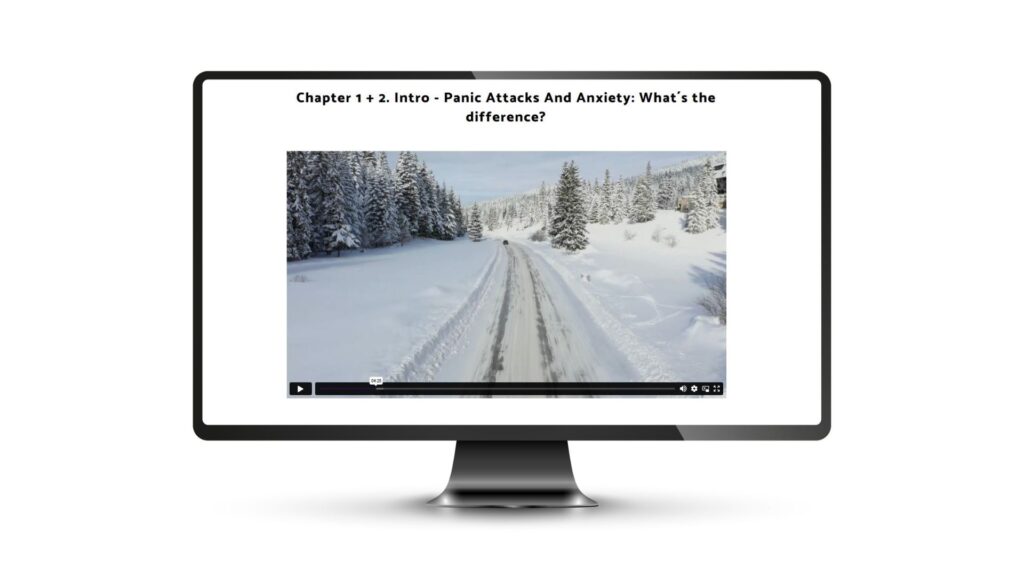Do panic attacks keep showing up - no matter what you try?
Your heart races, your chest feels tight, and no matter how many tests you’ve done — you’re told nothing is wrong.
When panic keeps interrupting your life, it can feel like there´s no way out. You´re not alone. With 9 hours of structured lessons and instant online access, this program helps you understand what’s really happening in your body and mind — and develop strategies with a long-term focus, not just another quick fix.
9 hours of structured video
Strategies for long-term change
38 expert-led chapters
Real-life examples
Learn at your own pace - No diagnosis needed
Normally $150 — now just $27 for the first 50 members
Therapy can involve long waitlists, and quick solutions don’t address the whole picture. This program was designed as a practical, science-based resource you can start with today.
To make it more accessible, I’ve set a special low launch price. Later, the price will return to its normal level.
Yes, I want access30 days money back guarantee. Try it risk-free and see if it is right for you.Take your time…
Not sure if it’s right for you?
See exactly what’s included in the program, or join the newsletter to receive a free sample lesson straight to your inbox.
Get free sampleView Program DetailsIf you’ve ever felt like panic comes out of nowhere and takes over your life...
… You’re not alone. It can start suddenly, without warning. One moment you’re fine, the next your body is in full alarm.
If you recognize yourself in one or more of these experiences, know that this program was created with you in mind.
- Your heart races, your chest feels tight, your breath turns shallow, or your hands tingle - even when doctors find “nothing wrong.”
- You live with constant fear of when the next wave of panic might strike.
- You catch yourself scanning your body for every small sensation, convinced it might be the start of another attack.
- You've started avoiding places like driving through tunnels, traffic jams, trains, restaurants, malls, or grocery stores, as these locations tend to trigger panic attacks.
- Everyday life shrinks. Driving, restaurants, trains, even grocery stores start to feel impossible.
- Despite thorough medical testing, no physical cause is found, leaving you feeling helpless and confused.
- The episodes keep returning, and nothing you’ve tried so far has broken the cycle.
These experiences are more common than you think. And with the right psychological tools, it’s possible to understand panic in a new way – and begin to respond differently.
A Step-by-Step Guide to Navigating Panic
Everything you need to know about panic – explained simply and grounded in science
What a panic attack really is (deep down) and what actually happens in your body and mind when it strikes
The specific mechanisms causing panic attacks and why they’re so persistent and keep coming at you
The same evidence-based strategies psychologists use in therapy, explained step-by-step so you can use them yourself
What panic attacks feel like, how long they typically last, the diagnostic criteria, and recommended steps for coping during an attack
How panic attacks fundamentally differ from anxiety (even if the two get mixed up all the time)
How the most influential psychological models behind panic and agoraphobia work — simplified and made easy to understand.
Why breathing matters more than you think: how hyperventilation fuels the panic cycle and how to regain control
Evidence-based strategies and principles for constructing anxiety hierarchies that make exposure therapy more effective
Why This Price Right Now?
I created this program to make science-based knowledge about panic more accessible. That’s why I’m opening it at a much lower price in the beginning.
The first 50 members can join for just $27 and get 12 months of access. As the program grows, I’ll be gathering feedback and experiences from participants to keep improving it.
This is a limited-time offer. Once those spots are filled, the price will increase.


“He truly understands what you mean. He listens and genuinely tries to help in the best way possible. Very easy to talk to, and I feel better after every session.”

“I received help with my fears. It feels amazing that it worked so quickly.”

“Exceptionally skilled and professional. Very grateful for all the help.”
Meet the Psychologist Behind the Program
Hi, I’m Robert — a licensed psychologist based in Sweden. For more than a decade, I’ve supported people struggling with panic attacks, anxiety, and emotional exhaustion in both clinical care and private practice.
Over the years, I’ve seen the same painful pattern again and again: panic is often misunderstood, dismissed, or left unexplained. Too many people end up facing it alone, without access to clear, science-based guidance.
That’s what inspired me to create this program. Drawing on evidence-based methods like Cognitive Behavioral Therapy (CBT) and other established approaches, I’ve designed it to bring the same psychological insights I use in therapy rooms into an accessible, step-by-step format.
As a psychologist specializing in panic, my role here is to guide you through what’s really happening — in your body, your brain, and your thoughts — and to share practical tools you can start applying in everyday life.
I believe everyone deserves clarity, and access to knowledge that helps make panic less overwhelming, and more manageable.
Please note: I am licensed to practice psychology in Sweden. This program is a self-help resource, not a substitute for personalized psychological assessment, diagnosis, or treatment. It’s designed to share science-based knowledge and practical tools, but it does not replace therapy.
What´s inside the program?
An Immersive Learning Experience

This isn’t just a collection of videos—it’s an experience designed to engage both your mind and your curiosity.
The program was built to be immersive and even entertaining, blending solid science with storytelling, visuals, and real-life examples.
- 38 chapters with almost 9 hours of structured video lessons exploring the biology, psychology, and lived experience of panic.
- Downloadable worksheets and psychoeducational exercises for deeper insight and personal exploration.
- True-to-life clinical scenarios and stories that bring concepts to life.
Specific and focused
What makes this program different?
This self-guided program was created by a licensed psychologist with years of experience helping people facing panic. It’s built entirely on evidence-based methods refined through decades of research.
Unlike generic self-help courses that treat panic as “just stress” or “general anxiety,” this program focuses specifically on panic attacks, panic disorder, and agoraphobia.
It’s not therapy, but it is therapy-informed — grounded in modern CBT, illustrated with real-life examples, and designed to be both clear and practical.
Instead of skimming the surface, it takes you step by step through what panic really is, why it happens, and how to respond differently — with explanations, visuals, and insights that actually stick.

Accessible and flexible
Explore at your own pace

- Accessible from anywhere – follow the program online, in your own time and on your own terms.
- This self-guided program offers practical tools and guided reflection to support your understanding of panic and how it affects your life.
- Through hands-on exercises, you’ll explore new ways to relate to fear and build strategies for facing it more intentionally.
Here´s exactly what you´ll learn
Course Breakdown
The Surprising Truth About Panic: What It Is and Why It Starts
Chapters 1–4
In chapter one, the viewer is introduced to Susan, a woman who, quite suddenly and out of nowhere, experiences her very first panic attack. The focus is intimate—offering a perspective from within her own experience, while also weaving in psychological and medical insights striving to illuminate what’s unfolding beneath the surface. Chapters two and three expand the horizon and delve into what a panic attack truly is, the mechanisms involved, and how panic attacks differ profoundly from anxiety and fear—both driven by entirely different processes and serving very different functions.
Additionally, chapters two and three present a simple yet effective model for grasping panic attacks, paired with an easy-to-understand overview of the diagnostic criteria for panic disorder. Through vivid storytelling, these concepts are transformed from abstract ideas into relatable, real-world experiences. The narrative also takes the opportunity to shed some light on commonly occurring symptoms during and after a panic attack that are not included or listed in the DSM-5, but which are often present among patients, providing thorough explanations to deepen understanding.
In chapter four, the story brings us to Rachel—a young woman who shares her upbringing, her first terrifying panic attack, and the sudden onset of panic disorder that reshapes her whole life.
The Hidden Triggers That Keep You Stuck
Chapters 5–6.6
In chapters five and six, we offer a detailed, research-based perspective on what happens in the body and brain during a panic attack—going far beyond common explanations you might have seen elsewhere. Instead of relying on general terms like “stress,” “fight or flight,” or “anxiety,” we explore the specific neuroscientific mechanisms. The journey begins deep inside the brain, with the hypothalamus, and continues through the sympathetic nervous system, the intricate workings within our neurons, the complex interplay of proteins, neurotransmitters, and hormones, and the adrenal medulla, before finally arriving at the heart, where we learn more about how the electrical conduction system actually functions.
Based on current neuroscientific research, these chapters outline the biochemical mechanisms behind a panic attack—not vague talk about “stress,” “anxiety,” or “a fight or flight response,” which may not fully capture the complexity involved.
Furthermore, chapters 6.1 through 6.6 outline a variety of potential triggers that might ignite a panic attack—from disturbances originating in the gut, over-breathing, episodes of derealization (unreal experiences), to irregularities in the nervous system itself. Here, you’ll find a detailed, science-based explanation that cuts through the noise, challenges superficial narratives, and guides you toward a genuine understanding of what sparks panic—and why. Understanding what panic truly is has proven crucial, and that is precisely what chapters five through 6.6 aim to do: give you a comprehensive picture of what a panic attack really consists of.
How Panic Escalates: From Single Attack to Panic Disorder
Chapters 7–10
Across chapters seven to ten, we revisit Rachel’s story, as her very first panic attack unfolds into repeated waves of terror and dramatic behavioral changes, ultimately leading to a pattern of recurring attacks, consistent with panic disorder. More significantly, we get to know her thoughts—how she scrutinizes every sensation in her body, avoids certain drinks, and gradually reshapes her behavior in countless ways—all in a desperate attempt to ward off further episodes, and the profound consequences these changes bring over time.
As the journey continues, we gain insight into the brain’s radar system, uncovering the close connections between panic, perception, interpretation, anxiety, and thoughts—and what current research suggests occurs within the amygdala.
Next, we meet Sam, a man in his mid-forties, whose journey begins with his very first panic attack, winds through a series of medical consultations and behavioral changes, and ultimately leads to an all-consuming fear of everyday places such as restaurants, trains, and beyond.
Finally, chapter ten unpacks why certain thoughts, behaviors, and coping strategies aimed at avoiding panic often backfire over time, fueling even more panic—a phenomenon known as the self-fulfilling prophecy.
Conditioned Fear and Thought Loops
Chapters 11–15
In chapters eleven through fifteen, we are introduced to a comprehensive range of psychological models designed to explain the development of anxiety and fear—more specifically, the mechanisms by which a single panic attack may escalate into recurrent episodes, ultimately culminating in panic disorder. These chapters provide an in-depth examination of various types of conditioning, including classical and operant conditioning, and clarify how these learning processes fundamentally shape human experience and behavior.
In chapters thirteen and fourteen, the focus shifts to a detailed analysis of cognition. In this section, we examine what defines an automatic thought, how the autonomous part of the brain—or mind—functions, and how cognitive processes influence emotional responses and behavioral patterns.
Finally, chapters fourteen and fifteen offer a structured overview of professional therapeutic methods, and interventions used to address negative automatic thoughts and regulate the autonomic nervous system. This section encompasses a wide range of evidence-based approaches, including Cognitive Behavioral Therapy (CBT), Acceptance and Commitment Therapy (ACT), Metacognitive Therapy (MCT), and related modalities. Each model is illustrated with concrete examples drawn from real-world panic-attack experiences.
Building Your Recovery Map: The Models That Make Panic Click
Chapters 16–18
In chapters sixteen through eighteen, we introduce more advanced, research-based models of panic attacks, panic disorder, and agoraphobia—developed through decades of peer-reviewed research. To demonstrate these models in practice, the journeys of both Rachel and Sam are interwoven as concrete examples, illustrating each model in action and providing an overview of techniques that clinical psychologists often use in their work with panic symptoms. Significant emphasis is placed on the practical techniques and strategies clinical psychologists often use when working with panic symptoms.
Chapters sixteen through eighteen further contrast different types of panic attacks, highlighting particularly how stress, burnout, grief, and emotional states may influence the onset and progression of panic attacks and panic disorder.
The section concludes with an exercise inspired by Motivational Interviewing (MI), designed to support self-reflection and personal goal setting.
From Fear to Fearlessness: Exposure and Long-Term Change
Chapters 19–20.2
In chapters nineteen through 20.2, we zero in on the essence of exposure methods—a widely studied approach in clinical literature for addressing panic attacks, clarifying common misconceptions and revealing why exposure is not just about facing your fears but understanding its underlying mechanisms. Exposure is often portrayed superficially, yet research and clinical guidelines emphasize that it requires extensive expertise, precise knowledge, and refined skills. This section provides a detailed overview of the core principles of exposure work, including how to plan exposures, construct anxiety hierarchies, and recognize common pitfalls, while outlining frequent errors and misconceptions that can derail exposure efforts rather than resting on simplistic slogans.
Moreover, chapter 20 explores how exposure to thoughts works and how mental—or imaginary—exposure differs from interoceptive or in vivo exposure. Altogether, chapter 20 provides an overview of techniques described in clinical research, explaining how anxiety hierarchies are structured, what to prioritize when structuring your own, and which common pitfalls to watch for.
Chapters nineteen through 20.2 are also designed to distinguish coping strategies from safety behaviors, and safety behaviors from simple avoidance. Furthermore, chapter 20 includes a detailed examination of how thoughts interact during exposure and why managing these cognitive processes is pivotal. The chapter concludes by illustrating through Sam’s and Rachel’s experiences how exposure methods are applied in practice and the factors clinicians consider to support effective implementation.
Rebalancing Body and Mind
Chapters 21–22
Chapters twenty-one and twenty-two present an overview of research-based relaxation and breathing approaches commonly discussed in clinical literature. These chapters offer theoretical explanations and practical demonstrations of methods often utilized by professionals to support self-management of panic attacks, anxiety, and stress. Chapter twenty-one is divided into six distinct sections, guiding the viewer step-by-step through a range of techniques—from simple breathing exercises to more advanced relaxation practices—that can be adapted to different situations and states. Finally, chapter twenty-two explores additional habits and behaviors that may influence the likelihood of experiencing further panic attacks.
Simple Pricing
- Special launch offer
For a limited time, the first 50 members get 12 months of access for just $27 (normally $150).
Pricing
No hidden fees. No subscription.-
1 year of full access: Revisit the material as often as you like.
-
Step-by-step lessons: Move through the content at your own pace.
-
38 structured chapters – broken into manageable, topic-specific segments
-
Based on modern cognitive behavioral science (CBT), but with a storytelling twist
-
Practical exercises: Explore techniques grounded in psychological principles.
-
General email support for technical or program-related questions
-
30 days full money back guarantee
Note: This is a self-help program and not a replacement for therapy or medical treatment.
The Story
From Fear to Insight: Why I Created This Program
As a psychologist, I’ve met so many people who felt trapped in the world of panic. Some waited months for help that never came. Others were told “it’s nothing” — or left with advice that didn’t touch what they were really going through. Again and again, I’ve seen how panic leaves people feeling misunderstood, dismissed, or simply stuck with no clear way forward.
Panic can feel overwhelming and deeply isolating. One moment you’re fine, the next your body is in full alarm — and even when doctors say “everything looks normal,” the fear still lingers. It’s not just the attacks themselves, but the constant anticipation, the shrinking of daily life, the sense of living in a cycle you can’t control.
I created this program because no one should have to face that cycle alone. My goal was to build something practical and accessible, grounded in psychological science but delivered in a way that actually resonates. Step by step, the program offers clear explanations of what panic is and why it happens, alongside strategies you can try at your own pace.
Because I believe everyone deserves not only answers, but also a sense of clarity — and with that, the possibility to feel more grounded, more capable, and less defined by panic.

“I got help with my difficulties. Very satisfied.”